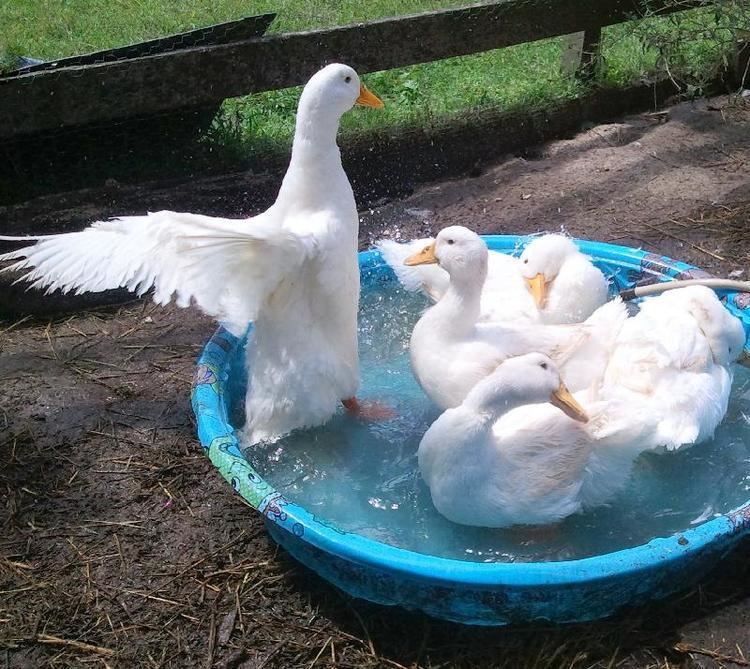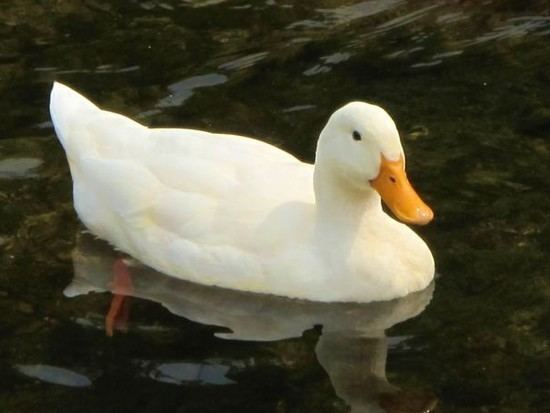Other names White Pekin Distribution World-wide Rank Breed | Country of origin China Origin China | |
 | ||
Conservation status FAO (2007): not at risk Use Meat and egg production Weight Male: 4.1 kg
Female: 3.6 kg Scientific name Anas platyrhynchos domesticus Similar Indian Runner duck, Khaki Campbell, Rouen duck, Call duck, Cayuga duck | ||
The American Pekin Duck, also known as the Peking, White Pekin, American Pekin, Pekin, and Long Island duck. Anas platyrhynchos domesticus is a breed of domestic duck. It originated from the mallard in China, and is now distributed in many countries, and in all continents.
Contents
- History
- Hatching
- Hatchlings and Ducklings
- Sexing
- Adults
- Use for Meat Production
- Use for Egg Production
- Use As Pets Companion Animals
- References

The American Pekin Duck is used primarily for egg and meat production. It was bred from the mallard in China. Pekin ducks are not generally found in the wild.
The American Pekin Duck is the most popular commercial breed of duck in the United States, after a small number were imported to Long Island from China in 1872.

Pekin ducks bear a superficial resemblance to a British duck breed, the Aylesbury. Pekins can be distinguished from Aylesbury Ducks by their larger overall size, bright orange-yellow beaks and more upright posture.
The American Pekin Duck and German Pekin Duck have a close resembelence to each other, but are considered separate breeds.
History
The Pekin duck was domesticated from the mallard in China, probably before 2500 BC. They were brought into north america in 1872.
In 1872, at the request of a businessman named McGrath, fifteen Pekin ducks - hatched in Peking - were loaded at Shanghai by James E. Palmer, of Stonington, Connecticut, for shipment to the United States. Nine of the ducks – six hens and three drakes – survived the voyage, which took 124 days, and reached New York City in March 1873.
The Pekin was included in the first edition of the Standard of Perfection of the new American Poultry Association. It was soon in widespread use for production of birds for slaughter.
The Pekin was introduced to Germany and to the United Kingdom in 1874, and is known as the German Pekin in those countries. The German Pekin has been bred much differently then the version found in north america, and have a more upright stance. The 'Entente Européenne d’Aviculture et de Cuniculture' lists the American Pekin and the German Pekin ducks as separate breeds.
Hatching
Pekin ducks take around 28 days to develop and hatch at 99.5°F (37.5°C) and 55% humidity. A heartbeat can usually be seen by the third day of incubation when candling the egg.
The eggs must be regularly turned during incubation. This occurs in nature when the duck that is hatching the eggs shifts its position while sitting on the eggs. For artificial incubation, machines are sometimes used which will constantly turn the eggs, or this can be done by hand.
When being artificially incubated, the ducklings can be moved to a "hatcher", three days before they are due to hatch. This has a slightly lower temperature and higher humidity which increases the survivability of the hatchlings while their protective down develops.
Compared with other birds, duck eggs hatch relatively easily, and are forgiving of variations in temperature and humidity.
Hatchlings and Ducklings
Pekin hatchlings have bright yellow plumage with an orange bill, shanks, and feet.
The feathers of a young duckling are not sufficiently developed to properly protect them for extended periods in the water, and they do not produce enough preen oil to waterproof this plumage and allow them to float. In the wild, an adult member of the flock will 'monitor' the time that the ducklings spend in the water, as well as supplying additional preen oil to supplement what is produced by the hatchlings. Hatchings that have been raised by humans are more likely to drown if given free access to swimming water, and cannot swim on their own until 5 or 6 weeks of age.
Sexing
It can be difficult to determine the sex of young ducklings due to the lack of external genitalia or other differences. Venting is one common method; this entails gently squeezing the duckling to cause feces to be expelled, which forces the cloaca to open slightly, permitting the sexer to view the sexual organs; however, these are almost undifferentiated in hatchlings.
As a male duck matures it acquires a curled tail feather called a drake feather. Much like their wild ancestor, the mallard, males develop a deep rasping call, while females quack. Female pekins are also known to make a low 'cluck' like noise when content. Venting is also easier when the ducks' genitals are fully mature but is not necessary because of the readily-apparent external differences between males and females.
Adults
Fully mature adult Pekin ducks weigh between 8 and 11 pounds (3.6 and 5 kilograms) in captivity. Their average lifespan is about 9 to 12 years. Their external feathers are white, sometimes with a yellowish tinge. This is more obvious with ducks that have been raised indoors and not exposed to sunlight, rather than ducks that have been raised outside. Pekin ducks have a more upright stance than dabbling ducks, and possess an upturned rump. American Pekin Ducks have dark grayish-blue eyes that may appear black when seen far away. They have orange bills and orange legs (shanks).
Under some circumstances, Pekin ducks will hatch out eggs on their own, although the are less 'broody' than other ducks, meaning they will incubate eggs less frequently, and are more likely to abandon their nest before their eggs hatch.
Pekin ducks, for the most part, are too heavy to get airborne. While some individual ducks may be lighter and capable of short bursts of vertical flight, therefore, farms will often avoid clipping the wings of their ducks (pinioning).
Pekin Ducks are gregarious and will usually group together with other ducks.
As with most waterfowl, a Pekin duck's foot is adapted for swimming through water, but is also capable of walking on dry land.
Pekin ducks are able to stay afloat in water because their feathers are coated in a light preen oil, and their feathers hold in pockets of air.
Use for Meat Production
Pekin ducks are used commonly for the production of meat, because of their quick growth rates.
Use for Egg Production
An adult Pekin will lay an average of 200 eggs per year if it does not try to hatch them, or is prevented from hatching them. They will normally only lay one egg on any given day. They will lay their eggs in what they consider to be a safe place and will often lay where another duck has already laid (egg dumping). The laying period of a Pekin duck can be extended by using artificial light supplementation.
Use As Pets / Companion Animals
As precocial birds, Pekin ducks are often used as companions for other animals. Pekin ducks more intelligent than most domestic birds, and are capable of strong bonds with other animals and humans, and can sometimes prefer human company over the company of other ducks.
Like geese, Pekin ducks can be used as guard animals, and can provide warning of approaching dangers, such as predators.
